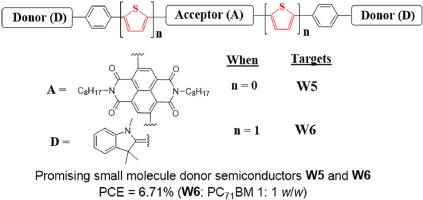Dyes and Pigments ( IF 4.1 ) Pub Date : 2020-08-29 , DOI: 10.1016/j.dyepig.2020.108808 Sopan M. Wagalgave , Sheshanath V. Bhosale , Avinash L. Puyad , Jing-Yu Chen , Lathe Jones , Jing-Liang Li , Akhil Gupta , Sidhanath V. Bhosale

|
Two new organic semiconductors based on indoline and naphthalene diimide building blocks are reported for solution-processed bulk-heterojunction devices. Both materials, coded as W5 and W6, were based on the donor–acceptor–donor structural format, where indoline was used as a terminal donor and the naphthalene diimide unit was the central acceptor. Both W5 and W6 were designed to be the structural analogues where a phenyl ring was used as a π-linker in the former, and the latter comprised an additional thiophene ring. The π-linkers were induced between the donor (indoline) and acceptor (naphthalene diimide) functionalities. As a result of adding a thiophene ring in W6, its thin film demonstrated improved light-harvesting properties together with a narrower optical band gap. The photovoltaic properties were evaluated using solution-processed, bulk-heterojunction devices and W6 afforded a promising power conversion efficiency of 6.71% when tested as a donor material together with the conventional acceptor ([6,6]-phenyl-C71-butyric acid methyl ester (PC71BM)). The efficiency exhibited by W6: PC71BM is approximately 50% higher than the device based on the W5 blend (4.49%). To our knowledge, W5 and W6 are the first reported examples in the literature where indoline and naphthalene diimide units are linked together, and the optoelectronic and photovoltaic properties have been altered with the incorporation of a thiophene ring within the investigated molecular backbone.
中文翻译:

基于吲哚啉和萘二酰亚胺功能的供体-受体-供体模型供体目标,可用于高效的本体异质结器件
据报道,有两种基于二氢吲哚和萘二酰亚胺构建基的新型有机半导体用于溶液处理的本体异质结器件。两种材料的代码分别为W5和W6,都是基于供体-受体-供体的结构形式,其中吲哚被用作末端供体,萘二酰亚胺单元是中央受体。既W5和W6被设计为,其中被用作前者的π接头的苯环的结构类似物,而后者包括一个额外的噻吩环。在供体(二氢吲哚)和受体(萘二酰亚胺)官能团之间诱导了π-接头。由于在W6中添加了噻吩环,其薄膜表现出改善的集光性能以及更窄的光学带隙。使用溶液处理的本体异质结器件评估了光伏性能,当与常规受体([6,6]-苯基-C 71-丁酸)一起用作供体材料进行测试时,W6可以提供6.71%的有前途的功率转换效率甲酯(PC 71 BM))。W6:PC 71 BM表现出的效率比基于W5混合物的设备(4.49%)高约50%。据我们所知,W5和W6 是文献中第一个报道的例子,其中吲哚啉和萘二酰亚胺单元连接在一起,并且通过在所研究的分子主链中并入噻吩环,改变了光电和光伏特性。










































 京公网安备 11010802027423号
京公网安备 11010802027423号